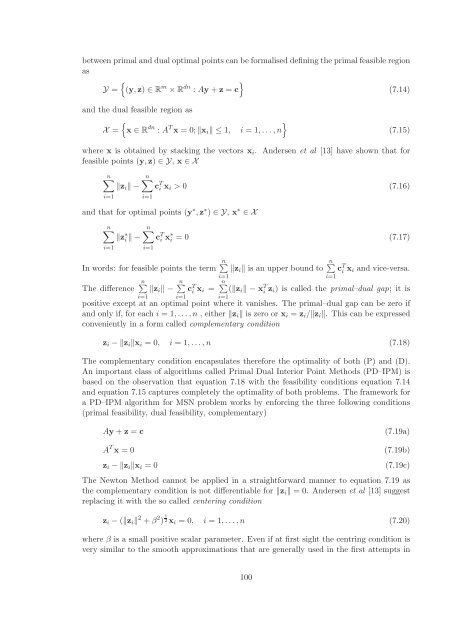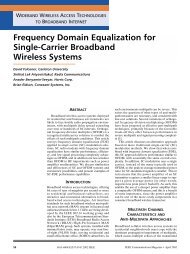Image Reconstruction for 3D Lung Imaging - Department of Systems ...
Image Reconstruction for 3D Lung Imaging - Department of Systems ...
Image Reconstruction for 3D Lung Imaging - Department of Systems ...
You also want an ePaper? Increase the reach of your titles
YUMPU automatically turns print PDFs into web optimized ePapers that Google loves.
etween primal and dual optimal points can be <strong>for</strong>malised defining the primal feasible region<br />
as<br />
�<br />
Y = (y,z) ∈ R m × R dn �<br />
: Ay + z = c<br />
(7.14)<br />
and the dual feasible region as<br />
�<br />
X = x ∈ R dn : A T �<br />
x = 0; �xi� ≤ 1, i = 1,... ,n<br />
(7.15)<br />
where x is obtained by stacking the vectors xi. Andersen et al [13] have shown that <strong>for</strong><br />
feasible points (y,z) ∈ Y, x ∈ X<br />
n�<br />
�zi� −<br />
i=1<br />
n�<br />
i=1<br />
c T i xi > 0 (7.16)<br />
and that <strong>for</strong> optimal points (y ∗ ,z ∗ ) ∈ Y, x ∗ ∈ X<br />
n�<br />
i=1<br />
�z ∗ i � −<br />
n�<br />
i=1<br />
c T i x∗ i<br />
= 0 (7.17)<br />
In words: <strong>for</strong> feasible points the term n�<br />
�zi� is an upper bound to n�<br />
i=1<br />
The difference n�<br />
�zi� − n�<br />
cT i xi = n�<br />
i=1<br />
i=1<br />
c<br />
i=1<br />
T i xi and vice-versa.<br />
(�zi� − x<br />
i=1<br />
T i zi) is called the primal–dual gap; it is<br />
positive except at an optimal point where it vanishes. The primal–dual gap can be zero if<br />
and only if, <strong>for</strong> each i = 1,... ,n , either �zi� is zero or xi = zi/�zi�. This can be expressed<br />
conveniently in a <strong>for</strong>m called complementary condition<br />
zi − �zi�xi = 0, i = 1,... ,n (7.18)<br />
The complementary condition encapsulates there<strong>for</strong>e the optimality <strong>of</strong> both (P) and (D).<br />
An important class <strong>of</strong> algorithms called Primal Dual Interior Point Methods (PD–IPM) is<br />
based on the observation that equation 7.18 with the feasibility conditions equation 7.14<br />
and equation 7.15 captures completely the optimality <strong>of</strong> both problems. The framework <strong>for</strong><br />
a PD–IPM algorithm <strong>for</strong> MSN problem works by en<strong>for</strong>cing the three following conditions<br />
(primal feasibility, dual feasibility, complementary)<br />
Ay + z = c (7.19a)<br />
A T x = 0 (7.19b)<br />
zi − �zi�xi = 0 (7.19c)<br />
The Newton Method cannot be applied in a straight<strong>for</strong>ward manner to equation 7.19 as<br />
the complementary condition is not differentiable <strong>for</strong> �zi� = 0. Andersen et al [13] suggest<br />
replacing it with the so called centering condition<br />
zi − (�zi� 2 + β 2 ) 1<br />
2xi = 0, i = 1,... ,n (7.20)<br />
where β is a small positive scalar parameter. Even if at first sight the centring condition is<br />
very similar to the smooth approximations that are generally used in the first attempts in<br />
100





